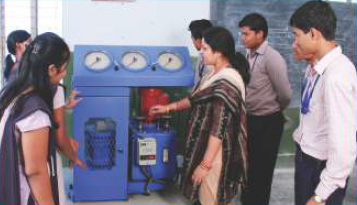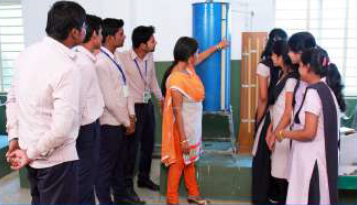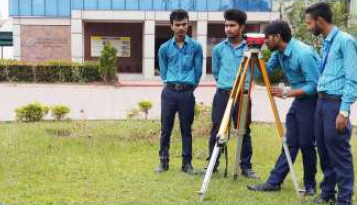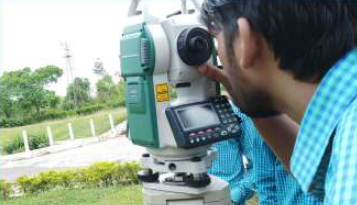Civil Engineering
About Us
The Civil Engineering Department started in the year 1997 and it is one the oldest department of
Nilachal polytechnic. The department has a competent group of faculties nurturing the students
with skills and knowledge.
Vision
To impart knowledge and excellence in Civil Engineering with global prospective to our student
and to make them strong technocrats to build the nation.
Mission
- M1 : To produce civil Diploma Engineering of high caliber technically skill with ethical values to solve
the society and nation.
- M2 : To impart fundamental knowledge of Civil Engineering to the student with concept of plan analyse,
design, execute and manage the Civil Engineering projects to meet industrial need.
- M3 : To promote innovative and original ideas in the budding technocrats to face the challenge of the
future.
Program outcomes (POS)
- PO1. Basic and Discipline specific knowledge : Apply knowledge of basic mathematics , science and
engineering fundamentals and engineering specialization to solve the engineering problems.
- PO2. Problem analysis : Identify and analyse well defined engineering problems using codified
standard methods.
- PO3. Design/development of solutions : Design solutions for well defined technical problems and
assist with the design of systems components or processes to meet specified needs.
- PO4. Engineering Tools, Experimentation and Testing : Apply modern engineering tools and
appropriate technique to conduct standard tests and measurements.
- PO5. Engineering practices for society, sustainability and environment : Apply appropriate
technology in context of society, sustainability, environment and ethical practices.
- PO6. Project Management : Use engineering management principles individually, as a team member
or a leader to manage projects and effectively communicate about well-defined engineering
activities.
- PO7. Life-long learning : Ability to analyse individual needs and engage in updating in the context of
technological changes.
Program Educational Objectives
- PEO1 : To produce diploma engineers with a strong foundation to peruse a thriving professional and to
solve dynamic problem on civil engineering.
- PEO2 : To imbibe professional ethics to the diploma engineering with a commitment to a society and
environment.
- PEO3 : To integrate attitude teamwork and leadership skill in student to enable them for a logical approach
towards engineering problems.
Program Specific Outcomes
- PSO1 : To make the student industry ready improving their technical and managerial skill.
- PSO2 : To encourage the student to opt for higher studies for their career upliftment.
Infrastructure
Faculty Profile

Mala Acharya
M. PHIL
(15 Yrs Of Teaching Exp)

Sweta Sarangi
M.Tech
(5 Yearss of Teaching Exp)

Amrita Mallick
M.Tech
(5 Yrs of Teaching Exp)

Milan Pradhan
B.Tech
(3 Yrs of Teaching EXp)

MADHUSMITA BISWAL
M.Tech
(5 Yrs of Teaching Exp)
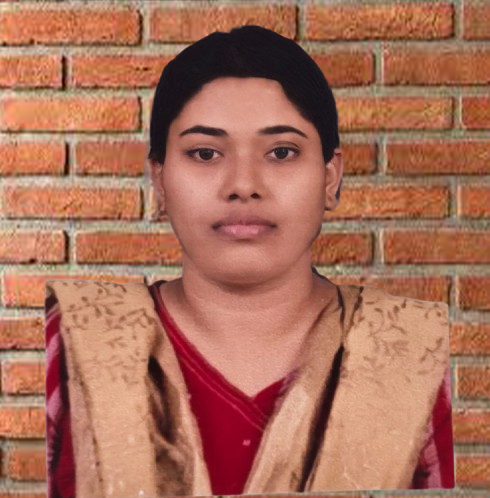
Sonalisa Routray
M.Tech
(5 Yrs of Teaching Exp)
Learning Material
3rd Semester
ENVIRONMENTAL STUDIES
Chapter 01
| The Multidisciplinary nature of environmental studies |
|
| The Multidisciplinary nature of environmental studies |
|
Chapter 04
| Biodiversity and it’s Conservation |
|
| Biodiversity and it’s Conservation |
|
Chapter 06
| Social issues and the Environment |
|
| Social issues and the Environment |
|
Chapter 07
| HUMAN POPULATION & THE ENVIRONMENT |
|
| Human population and the environment |
|
| Human population and the environment |
|
STRUCTURAL MECHANICS
Chapter 02
| Simple and Complex Stress, Strain |
|
| Simple and Complex Stress, Strain |
|
Chapter 05
| Shear Force and Bending Moment |
|
| Shear Force and Bending Moment |
|
Building Materials & Construction Technology
Geotechnical engineering
Chapter 02
| Preliminary Definitions and Relationship. 06 |
|
| Preliminary Definitions and Relationship |
|
Chapter 06
| Compaction and Consolidation. |
|
| Compaction and Consolidation |
|
Chapter 08
| Earth Pressure on Retaining Structures |
|
| Earth Pressure on Retaining Structures. |
|
Building materials and construction technology
Chapter 03
| Cement, Mortar and Concrete |
|
| Cement, Mortar and Concrete |
|
Chapter 04
| Other Construction Materials |
|
| Other Construction Materials |
|
Chapter 05
| Surface Protective Materials |
|
| Surface Protective Materials |
|
Chapter 06
| PART B: CONSTRUCTIONS TECHNOLOGY Introduction |
|
| PART B: CONSTRUCTIONS TECHNOLOGY Introduction |
|
Chapter 09
| Doors, Windows and Lintels |
|
| Doors, Windows and Lintels |
|
Estimation AND COST EVALUATION -I
Chapter 02
| Quantity Estimate of Building |
|
| Quantity Estimate of Building |
|
Chapter 03
| Analysis of Rates and Valuation |
|
| Analysis of Rates and Valuation |
|
Chapter 04
| Administrative Set-Up of Engineering Organisations |
|
| Administrative Set-Up of Engineering Organisations |
|
4th Semester
HYDRAULIC AND IRRIGATION ENGG
Chapter 04
| Water Requirement Of Crops |
|
Chapter 05
| Water Requirement Of Crops |
|
Chapter 07
| Water Logging And Drainage |
|
| Water Logging And Drainage |
|
Chapter 08
| Diversion Head Works And Regulatory Structures |
|
| Diversion Head Works And Regulatory Structures |
|
LAND SURVEY-I
Chapter 01
| Introduction To Surveying, Linear Measurements |
|
Chapter 02
| Chaining and Chain Surveying |
|
Chapter 03
| Angular Measurement and Compas Surveying |
|
Chapter 04
| Map Reading Cadastral Maps & Nomenclature |
|
Chapter 06
| Theodolite Surveying and Traversing: |
|
Chapter 08
| Computation of Area & Volume |
|
STRUCTURAL DESIGN -I
Chapter 01
| Working stress method (WSM) |
|
| Working stress method (WSM) |
|
Chapter 02
| Philosophy of Limit state method (LSM) |
|
| Philosophy of Limit state method (LSM) |
|
Chapter 03
| Analysis and design of singly and double reinforced sections (LSM) |
|
| Analysis and design of singly and double reinforced sections (LSM) |
|
Chapter 04
| Shear, Bond and Development Length (LSM) |
|
| Shear, Bond and Development Length (LSM) |
|
Chapter 05
| Analysis and Design of T-Beam (LSM) |
|
| Analysis and Design of T-Beam (LSM) |
|
Chapter 06
| Analysis and Design of Slab and Stair case (LSM) |
|
| Analysis and Design of Slab and Stair case (LSM) |
|
Chapter 07
| Design of Axially loaded columns and Footings (LSM) |
|
| Design of Axially loaded columns and Footings (LSM) |
|
5th Semester
ESTIMATNG AND COST EVALUATION-II
Chapter 04
| DETAILED ESTIMATES OF MISCELLANEOUS WORKS |
|
RAILWAY AND BRIDGE ENGINEERING
Chapter 04
| Geometric for broad gauge |
|
| Geometric for broad gauge |
|
Chapter 06
| Laying & maintenance of track |
|
Chapter 08
| Bridge site investigation, hydrology & planning |
|
Chapter 10
| Bridge substructure and approaches |
|
ESTIMATING AND COST EVALUATION -II
Chapter 01
| Detailed estimate of culverts and bridges |
|
| Detailed estimate of culverts and bridges |
|
Chapter 02
| Estimate of irrigation structures |
|
| Estimate of irrigation structures |
|
Chapter 03
| Detailed estimate of roads |
|
| Detailed estimate of roads |
|
Chapter 04
| Detailed estimates of miscellaneous works |
|
| Detailed estimates of miscellaneous works |
|
| Detailed estimates of miscellaneous works |
|
STRUCTURAL DESIGN -II
Chapter 02
| Structural Steel Fasteners and Connections |
|
| Structural Steel Fasteners and Connections |
|
Chapter 03
| Design of Steel tension Members |
|
| Design of Steel tension Members |
|
Chapter 04
| Design of Steel Compression members |
|
| Design of Steel Compression members |
|
Chapter 06
| Design of Tubular Steel Structures |
|
| Design of Tubular Steel Structures |
|
Chapter 07
| Design of Masonry Structures |
|
| Design of Masonry Structures |
|
WATER SUPPLY & WASTE WATER ENGINEERING
Chapter 01
| Introduction to Water Supply, Quantity and Quality of water |
|
| Introduction to Water Supply, Quantity and Quality of water |
|
Chapter 02
| Sources and Conveyance of water |
|
| Sources and Conveyance of water |
|
Chapter 04
| Distribution system and Appurtenance in distribution system |
|
| Distribution system and Appurtenance in distribution system |
|
Chapter 07
| Quantity and Quality of sewage |
|
| Quantity and Quality of sewage |
|
Chapter 09
| Sewer appurtenances and Sewage Disposal |
|
| Sewer appurtenances and Sewage Disposal |
|
6th Semester
LAND SURVEY-II
Chapter 03
| BASICS ON SCALE AND BASICS OF MAP |
|
Chapter 04
| SURVEY OF INDIA MAP SERIES |
|
Chapter 05
| BASICS OF AERIAL PHOTOGRAPHY, PHOTOGRAMMETRY, DEM AND ORTHO IMAGE GENERATION: |
|
Chapter 07
| BASICS ON GPS & DGPS AND ETS |
|
Chapter 08
| BASICS OF GIS AND MAP PREPARATION USING GIS |
|
CONSTRUCTION MANAGEMENT
Chapter 01
| Introduction To Construction Management |
|
Chapter 03
| Materials and Stores Management |
|
Chapter 04
| Construction Site Management |
|
Chapter 05
| Construction Organisation |
|
Chapter 06
| Construction Labour and Labour Management |
|
Chapter 10
| Safety Management In Construction |
|
ADVANCE CONSTRUCTION TECHNIC AND EQUIPMENT
Chapter 01
| Advanced construction materials |
|
Chapter 03
| Earthquake Resistant Construction |
|
Chapter 04
| Retrofitting of Structures |
|
Chapter 06
| Construction and earth moving equipments |
|
Chapter 07
| Soil reinforcing techniques |
|
CONCRETE TECHNOLOGY
Chapter 01
| Concrete as a construction material |
|
| Concrete as a construction material |
|
Chapter 03
| Aggregate, Water and Admixtures: |
|
| Aggregate, Water and Admixtures: |
|
Chapter 04
| Properties of fresh concrete |
|
| Properties of fresh concrete |
|
Chapter 05
| Properties of hardened concrete |
|
| Construction Organisation |
|
Chapter 08
| Inspection and Quality Control of Concrete |
|
| Inspection and Quality Control of Concrete |
|
Chapter 10
| Deterioration of concrete and its prevention: |
|
| Deterioration of concrete and its prevention: |
|
SCTE & VT Questions
For the Year 2023(S) :
For the Year 2023(W) :
For the Year 2022(S) :
For the Year 2022(W) :
For the Year 2021(S) :
For the Year 2021(W) :
For the Year 2020(S) :
For the Year 2020(W) :
For the Year 2019(S) :
For the Year 2019(W) :
For the Year 2018(S) :
For the Year 2018(W) :
